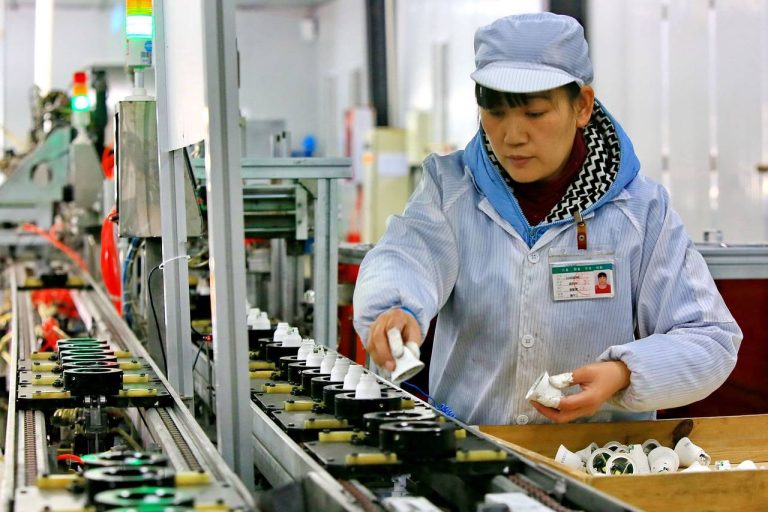Summary
- Triple-digit tariffs had posed a major threat of mass job losses and social unrest
- Trade war de-escalation has helped reduce risks to social stability
- Despite easing tensions, analysts warn many jobs remain at risk due to economic slowdown
BEIJING, May 16 (Reuters) – Chinese worker Liu Shengzun lost two jobs in the span of a month after the United States imposed triple-digit import tariffs in April. The steep levies forced a lighting factory in Guangdong to scale back operations, followed shortly by a footwear manufacturer. With few options left, Liu abandoned the search for factory work and returned to farming in his hometown in southern China. “It’s been extremely difficult this year to find steady employment,” said the 42-year-old, who once earned between 5,000 and 6,000 yuan ($693–$832) a month. Now, without stable income, he says he can barely afford food.
This week’s sharp reduction in tariffs has brought some relief and helped China narrowly avoid a feared scenario of mass layoffs and widespread social unrest—an outcome the Communist Party views as a critical threat to its legitimacy and grip on power. The rapid cooling of trade tensions after last weekend’s Geneva talks has reduced the immediate pressure on jobs and social stability.
Still, the economic damage from this year’s steep U.S. tariff hikes—peaking at 145%—continues to cast a shadow. Economists and policy advisers warn that despite the recent de-escalation, tariffs remain high enough to depress hiring and restrain China’s already slowing economic growth. “It was a win for China,” said a government policy adviser, requesting anonymity due to the sensitivity of the topic. “Factories can restart operations and avoid mass layoffs, which helps protect social stability.” But he cautioned that U.S. tariffs still sit at around 30% on top of preexisting duties, posing a serious burden. “It’s difficult to do business at 30%,” he said. “Over time, this will weigh on China’s economic development.”
Prior to the Geneva talks, Chinese authorities had grown increasingly anxious, as more firms—especially in labor-intensive sectors like furniture and toy manufacturing—faced mounting bankruptcy risks. Now, there’s cautious optimism. Lu Zhe, chief economist at Soochow Securities, estimates the number of jobs at risk has dropped to under 1 million from between 1.5 million and 6.9 million before the tariff cuts.
Alicia Garcia-Herrero, chief Asia Pacific economist at Natixis, had earlier projected that the previous tariff levels could have triggered as many as 6 to 9 million job losses. Under current tariffs, she expects 4 to 6 million jobs remain at risk, though if tariffs fall another 20%, the number of potential layoffs could decline to between 1.5 and 2.5 million. She also forecasted that China’s 2025 GDP growth could slow by 0.7 percentage points under the most favorable tariff scenario, by 1.6 points under current levels, or by as much as 2.5 points if the trade conflict reverts to April’s severity.
“When you raise tariffs to those kinds of levels, many companies stop hiring and start sending workers home,” Garcia-Herrero said. “At 30%, I doubt they’ll just rehire immediately. It’s still a high rate.” While she acknowledged the Chinese government may see the Geneva outcome as a breakthrough, she noted that many businesses remain unconvinced the easing will bring meaningful recovery. “Maybe the government is saying this was amazing. But many companies aren’t sure this is going to work,” she added.
Unstable Outlook: China Struggles to Offset Job Losses Amid Trade Tensions
In response to rising job losses in manufacturing, Chinese government advisers say Beijing is ramping up state investment in labor-intensive public projects and directing financial support through the central bank to sectors that could generate new employment.
Last week, the People’s Bank of China introduced a new lending tool aimed at providing low-cost funds to service industries and elderly care—part of a broader stimulus effort to cushion the blow from trade tensions and slowing growth.
“When it comes to employment, the key driver will be expanded government investment, as corporate investment sentiment remains subdued,” said Jia Kang, founding president of the China Academy of New Supply-Side Economics.
Although Beijing aims to maintain its budget deficit at around 4% of GDP—as planned during March’s legislative meetings—Jia noted that a higher deficit “cannot be ruled out” if economic conditions deteriorate further.
The full impact of April’s steep tariff hikes on employment remains unclear. While a recent factory activity survey indicated a decline in employment last month, analysts believe Beijing’s greater concern lies in the risk of accelerating job losses, rather than short-term figures.
Exporters had already begun trimming their workforce to stay competitive, contributing to what some fear could spiral into a deflationary trend.
“It’s difficult to pin down an exact number,” said a second government adviser, referring to job losses. “The economy is already weak, and the tariff war is like adding frost on top of snow—but it’s still just frost.”
Analysts point to a major obstacle to job creation: the unpredictability of U.S. trade policy under President Donald Trump. Ongoing uncertainty has kept many exporters cautious about expanding operations or hiring.
Li Qiang, who lost his job at a trading company that exported pneumatic cylinders for industrial machinery, was one of up to 20 workers let go after the firm lost U.S. clients and was undercut by competitors in Japan rushing to fill the vacuum left by American buyers.
Now working as a ride-hailing driver in the city of Chengdu, Li says he has no plans to return to export-related work, even as tensions between the U.S. and China ease.
“Trump’s policies toward China can change at any moment, which makes jobs in the export sector too unstable,” he said. “I’m not going to invest any more effort in that industry.”
($1 = 7.2109 Chinese yuan renminbi)
– Reported by Lian Gao, Kevin Lee, and the Beijing bureau; Additional reporting by Adam Zhang in Beijing; Written by Russell Zaharia; Edited by Charles Feast.

